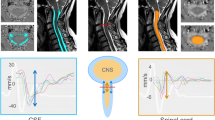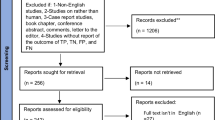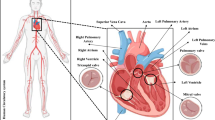Abstract
Additional hemodynamic parameters are highly desirable in the clinical management of intracranial aneurysm rupture as static medical images cannot demonstrate the blood flow within aneurysms. There are two ways of obtaining the hemodynamic information—by phase-contrast magnetic resonance imaging (PCMRI) and computational fluid dynamics (CFD). In this paper, we compared PCMRI and CFD in the analysis of a stable patient’s specific aneurysm. The results showed that PCMRI and CFD are in good agreement with each other. An additional CFD study of two stable and two ruptured aneurysms revealed that ruptured aneurysms have a higher statistical average blood velocity, wall shear stress, and oscillatory shear index (OSI) within the aneurysm sac compared to those of stable aneurysms. Furthermore, for ruptured aneurysms, the OSI divides the positive and negative wall shear stress divergence at the aneurysm sac.














Similar content being viewed by others
References
Natarajan, S.K., Xiang, J.P., Tremmel, M., et al.: Hemodynamic–morphologic discriminants for intracranial aneurysm rupture. Stroke 42, E139–E139 (2011)
Forget, T.R., Benitez, R., Vezneclaroglu, E., et al.: A review of size and location of ruptured intracranial aneurysms. Neurosurgery 49, 1322–1325 (2001)
Dhar, S., Tremmel, M., Mocco, J., et al.: Morphology parameters for intracranial aneurysm rupture risk assessment. Neurosurgery 63, 185–197 (2008)
Rahman, M., Smietana, J., Hauck, E., et al.: Size ratio correlates with intracranial aneurysm rupture status a prospective study. Stroke 41, 916–920 (2010)
Shojima, M., Oshima, M., Takagi, K., et al.: Magnitude and role of wall shear stress on cerebral aneurysm—computational fluid dynamic study of 20 middle cerebral artery aneurysms. Stroke 35, 2500–2505 (2004)
Nayak, K.S., Nielsen, J.F., Bernstein, M.A., et al.: Cardiovascular magnetic resonance phase contrast imaging. J. Cardiovasc. Magn. R 17, 71 (2015)
Schubert, T., Bieri, O., Pansini, M., et al.: Peak velocity measurements in tortuous arteries with phase contrast magnetic resonance imaging the effect of multidirectional velocity encoding. Investig. Radiol. 49, 189–194 (2014)
Veeraswamy, R.K., Birjiniuk, J., Ruddy, J.M., et al.: Phase-contrast magnetic resonance imaging reveals novel fluid dynamics in a patient-derived silicone model of descending thoracic aortic dissection. J. Vasc. Surg. 61, 128s–129s (2015)
Young, P.M., McGee, K.P., Bolster, B., et al.: Magnetic resonance 4D flow reveals unusual hemodynamics associated with aneurysm formation and a possible cause of cryptogenic stroke in a patient with aortic dissection. J. Comput. Assist. Tomogr. 38, 216–218 (2014)
Nakagawa, S., Murai, Y., Wada, T., et al.: 4D flow preliminary investigation of a direct carotid cavernous fistula due to a ruptured intracavernous aneurysm. BMJ Case Rep. 2015, 206084 (2015)
Cebral, J.R., Castro, M.A., Burgess, J.E., et al.: Characterization of cerebral aneurysms for assessing risk of rupture by using patient-specific computational hemodynamics models. Am. J. Neuroradiol. 26, 2550–2559 (2005)
Shojima, M., Oshima, M., Takagi, K., et al.: Role of the bloodstream impacting force and the local pressure elevation in the rupture of cerebral aneurysms. Stroke 36, 1933–1938 (2005)
Hassan, T., Timofeev, E.V., Saito, T., et al.: A proposed parent vessel geometry-based categorization of saccular intracranial aneurysms: computational flow dynamics analysis of the risk of factors for lesion rupture. J. Neurosurg. 103, 662–680 (2005)
Goubergrits, L., Schaller, J., Kertzscher, U., et al.: Statistical wall shear stress maps of ruptured and unruptured middle cerebral artery aneurysms. J. R. Soc. Interface 9, 677–688 (2012)
Kulcsar, Z., Ugron, A., Marosfoi, M., et al.: Hemodynamics of cerebral aneurysm initiation: the role of wall shear stress and spatial wall shear stress gradient. Am. J. Neuroradiol. 32, 587–594 (2011)
Sato, M., Saito, N., Sakamoto, N., et al.: High wall shear stress gradient suppress morphological responses of endothelial cells to fluid flow. IFMBE Proc. 25, 312–313 (2010)
Singh, P.K., Marzo, A., Howard, B., et al.: Effects of smoking and hypertension on wall shear stress and oscillatory shear index at the site of intracranial aneurysm formation. Clin. Neurol. Neurosurg. 112, 306–313 (2010)
Kawaguchi, T., Nishimura, S., Kanamori, M., et al.: Distinctive flow pattern of wall shear stress and oscillatory shear index: similarity and dissimilarity in ruptured and unruptured cerebral aneurysm blebs. J. Neurosurg. 117, 774–780 (2012)
Shimogonya, Y., Ishikawa, T., Imai, Y., et al.: Can temporal fluctuation in spatial wall shear stress gradient initiate a cerebral aneurysm? A proposed novel hemodynamic index, the gradient oscillatory number (GON). J. Biomech. 42, 550–554 (2009)
Xiang, J.P., Natarajan, S.K., Tremmel, M., et al.: Hemodynamic–morphologic discriminants for intracranial aneurysm rupture. Stroke 42, 144–152 (2011)
Cebral, J.R., Mut, F., Sforza, D., et al.: Clinical application of image-based CFD for cerebral aneurysms. Int. J Numer. Methods Biomed. Eng. 27, 977–992 (2011)
Zhang, Y., Deshpande, R., Huang, D., et al.: Numerical analysis of blast furnace hearth inner profile by using CFD and heat transfer model for different time periods. Int. J. Heat. Mass Transf. 51, 186–197 (2008)
Zhang, Y., Takao, H., Murayama, Y., et al.: Propose a wall shear stress divergence to estimate the risks of intracranial aneurysm rupture. Sci. World J. 2013, 160–169 (2013)
Balogh, M., Parente, A., Benocci, C.: RANS simulation of ABL flow over complex terrains applying an Enhanced k-epsilon model and wall function formulation: implementation and comparison for fluent and OpenFOAM. J. Wind Eng. Ind. Aerodyn. 104, 360–368 (2012)
Zakaria, M.S., Ismail, F., Tamagawa, M., et al.: Numerical analysis using a fixed grid method for cardiovascular flow application. J. Med. Imaging Health Inform. 6, 1483–1488 (2016)
Zhang, Y., Sia, S.F., Morgan, M.K., et al.: Flow resistance analysis of extracranial-to-intracranial (EC-IC) vein bypass. J. Biomech. 45, 1400–1405 (2012)
Berg, P., Stucht, D., Janiga, G., et al.: Cerebral blood flow in a healthy circle of willis and two intracranial aneurysms: computational fluid dynamics versus four-dimensional phase-contrast magnetic resonance imaging. J. Biomech. Eng. 136, 041003 (2014)
van Ooij, P., Schneiders, J.J., Marquering, H.A., et al.: 3D cine phase-contrast MRI at 3T in intracranial aneurysms compared with patient-specific computational fluid dynamics. Am. J. Neuroradiol. 34, 1785–1791 (2013)
Zhang, Y., Furusawa, T., Sia, S.F., et al.: Proposition of an outflow boundary approach for carotid artery stenosis CFD simulation. Comput. Methods Biomech. Biomed. Eng. 16, 488–494 (2013)
Dong, J.L., Wong, K.K.L., Tu, J.Y.: Hemodynamics analysis of patient-specific carotid bifurcation: a CFD model of downstream peripheral vascular impedance. Int. J. Numer. Methods Biomed. Eng. 29, 476–491 (2013)
Tariq, U., Hsiao, A., Alley, M., et al.: Venous and arterial flow quantification are equally accurate and precise with parallel imaging compressed sensing 4D phase contrast MRI. J. Magn. Reson. Imaging 37, 1419–1426 (2013)
Stankovic, Z., Allen, B.D., Garcia, J., et al.: 4D flow imaging with MRI. Cardiovasc. Diagn. Therapy 4, 173–192 (2014)
Isoda, H., Ohkura, Y., Kosugi, T., et al.: Comparison of hemodynamics of intracranial aneurysms between MR fluid dynamics using 3D cine phase-contrast MRI and MR-based computational fluid dynamics. Neuroradiology 52, 913–920 (2010)
Stalder, A.F., Liu, Z., Hennig, J., et al.: Patient specific hemodynamics: combined 4D Flow-Sensitive MRI and CFD. In: Computational Biomechanics Medicine: Soft Tissues and the Musculoskeletal Sys., Springer, New York, 27–38 (2011)
Berg, P., Roloff, C., Beuing, O., et al.: The computational fluid dynamics rupture challenge 2013-phase II: variability of hemodynamic simulations in two intracranial aneurysms. J. Biomech. Eng. 137, 121008 (2015)
Dong, J., Inthavong, K., Tu, J.: Image-based computational hemodynamics evaluation of atherosclerotic carotid bifurcation models. Comput. Biol. Med. 43, 1353–1362 (2013)
Acknowledgements
The project was supported by the Independent Research Fund of Tsinghua University (Grant 20141081265).
Author information
Authors and Affiliations
Corresponding author
Additional information
Xuemei Zhao and Rui Li have contributed equally to this paper.
Rights and permissions
About this article
Cite this article
Zhao, X., Li, R., Chen, Y. et al. Hemodynamic analysis of intracranial aneurysms using phase-contrast magnetic resonance imaging and computational fluid dynamics. Acta Mech. Sin. 33, 472–483 (2017). https://doi.org/10.1007/s10409-017-0636-0
Received:
Revised:
Accepted:
Published:
Issue Date:
DOI: https://doi.org/10.1007/s10409-017-0636-0




